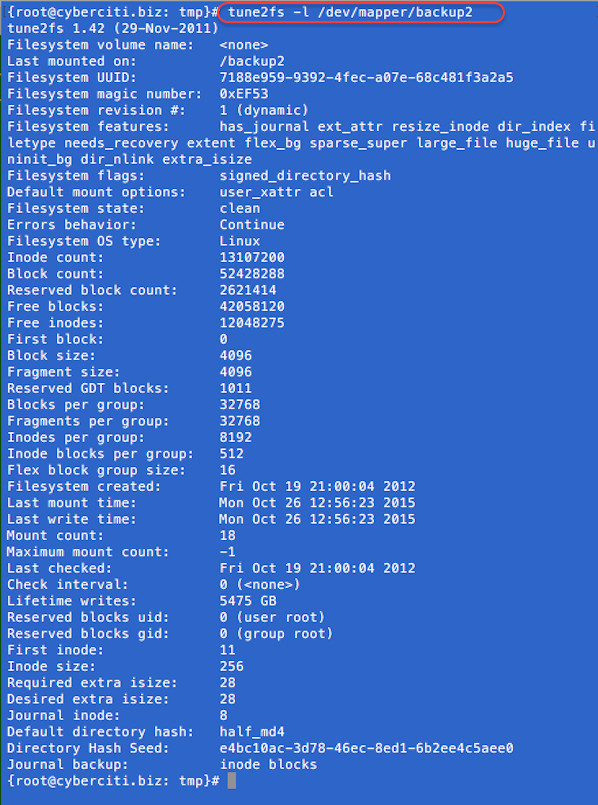http://www.cyberciti.biz/faq/linux-unix-display-characteristics-of-file-systems-command
How do I display the characteristics of file systems such as inodes, blocks, block size, file system name, state, lifetime writes, fsck status and more on Linux or Unix-like operating system?
You can use any one of the following command as per your Linux or Unix variant:
=> tune2fs command
=> lsfs command
=> fstyp command
=> df command
Sample outputs:
You can use grep command to filter out information. For example, to see lifetime writes on ext4 filesystem, enter:
Sample outputs:
The 'df -g' command the entire structure of the file system.
How do I display the characteristics of file systems such as inodes, blocks, block size, file system name, state, lifetime writes, fsck status and more on Linux or Unix-like operating system?
You can use any one of the following command as per your Linux or Unix variant:
=> tune2fs command
=> lsfs command
=> fstyp command
=> df command
Linux show file system characteristics
Pass the -l option to list the contents of the filesystem superblock, including the current values of the parameters that can be set via tune2fs command. Type the following command:# tune2fs -l /path/to/device | more
# tune2fs -l /dev/sda2 | grep
# tune2fs -l /dev/cciss/c1d1p1
# tune2fs -l /dev/mapper/dataSample outputs:
You can use grep command to filter out information. For example, to see lifetime writes on ext4 filesystem, enter:
# tune2fs -l /dev/md0 | grep 'writes'Sample outputs:
Lifetime writes: 90 GB
A note about HP-UX specific command
The fstyp command allows the user to determine the file system type of a mounted or unmounted file system. You need to pass special a device special file such as /dev/dsk/c1t6d0 and -v option to see information about the file system's superblock.# fstyp -v /dev/vg02/lvol2
# fstyp -v /dev/dsk/c1t6d0 | more
# df -g /dev/vg02/lvol2The 'df -g' command the entire structure of the file system.
A note about Solaris Unix to see the file system characteristics
Type the following command:# fstyp -v /dev/md/dsk/d200
# fstyp -v /dev/md/dsk/d200 | more
# df -g /dev/md/dsk/d200A note about AIX unix specific command
The lsfs command displays characteristics of file systems, such as mount points, automatic mounts, permissions, and file system size. The FileSystem parameter reports on a specific file system:# lsfs -q /dev/hd10admin
# lsfs -q / | more

No comments:
Post a Comment